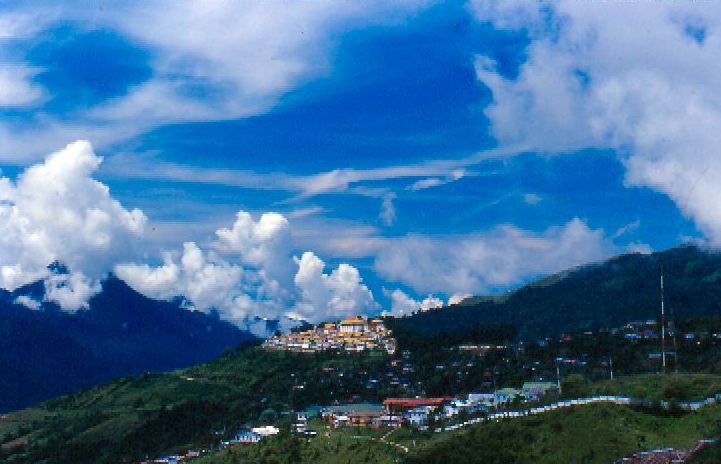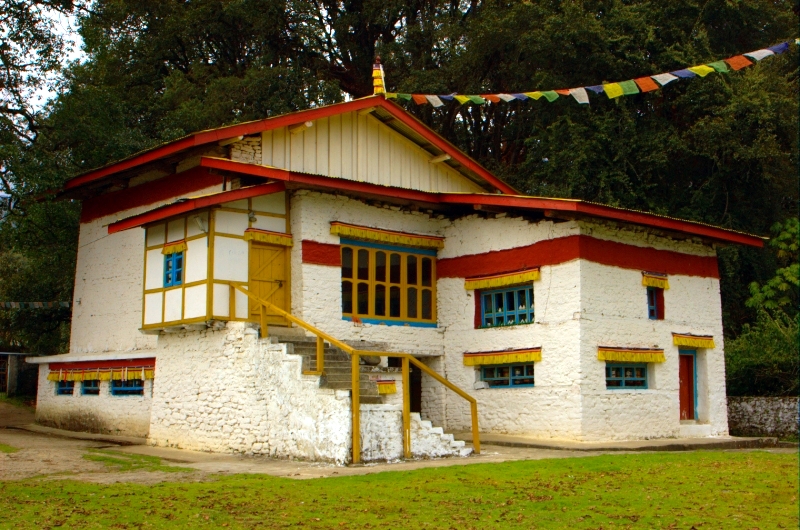|
Chumi Gyatse Falls
Chumi Gyatse Falls (), called Domtsang and Dongzhang waterfalls in Tibetan and Chinese languages respectively, are a collection of waterfalls in the Tawang district in Arunachal Pradesh, India, close to the border with the Tibet region of China. According to the local Buddhist tradition, the 108 holly water falls which originate from in-between the mountains symbolise the blessings of Guru Padmasambhava. The Chumi Gyatse Falls are close to the Line of Actual Control, the de facto border between China and India, just 250 metres away according to one account. Geography The Chumi Gyatse Falls are in an area called Yangtse where the Tsona Chu river flows from Tibet into India's Tawang district. They are along the cliff face of a high plateau ("Yangtse plateau") formed by an east–west mountain range, whose watershed serves as the India–China border as per the McMahon Line. A few hundred meters to the north, lies Domtsang () or Dongzhang () (), a Buddhist meditation site associa ... [...More Info...] [...Related Items...] OR: [Wikipedia] [Google] [Baidu] |
Tawang District
Tawang district (Pron:/tɑ:ˈwæŋ or təˈwæŋ/) is the smallest of the 26 administrative districts of Arunachal Pradesh state in northeastern India. With a population of 49,977, it is the eighth least populous district in the country (out of 707). History Tawang is inhabited by the Monpa people. From 500 BC to 600 AD a kingdom known as Lhomon or Monyul ruled the area. The Monyul kingdom was later absorbed into the control of neighbouring Bhutan and Tibet. Tawang Monastery was founded by the Merak Lama Lodre Gyatso in 1681 in accordance with the wishes of the 5th Dalai Lama, Ngawang Lobsang Gyatso, and has an interesting legend surrounding its name, which means "Chosen by Horse". The sixth Dalai Lama, Tsangyang Gyatso, was born in Tawang. Tawang was historically part of Tibet. The 1914 Simla Accord defined the McMahon Line as the new boundary between British India and Tibet. By this treaty, Tibet relinquished several hundred square miles of its territory, including Ta ... [...More Info...] [...Related Items...] OR: [Wikipedia] [Google] [Baidu] |
Tummo
In Tibetan Buddhism, ''tummo'' (; sa, चण्डाली, caṇḍālī) is the fierce goddess of heat and passion. Tummo is found in the Mahasiddha Krishnacarya and the ''Hevajra Tantra'' texts. Tummo is also a tantric practice for inner heat, developed around the concept of the female deity. It is found in the Six Dharmas of Naropa, Lamdre, Kalachakra. and Anuyoga teachings of Vajrayana. The purpose of tummo is to gain control over body processes during the completion stage of 'highest yoga tantra' (Anuttarayoga Tantra) or Anuyoga. Etymology ''Tummo'' (''gTum mo'' in Wylie transliteration, also spelled ''tumo'', or ''tum-mo''; Sanskrit ' or ''chandali'') is a Tibetan word, literally meaning 'fierce oman. ''Tummo'' is also the Tibetan word for 'inner fire.' ''Tummo'' may also be rendered in English approximating its phonemic pronunciation as ''dumo''. Practice Inner heat (''gtum mo'', skt. ''chandali,'' literally meaning "fierce, hot or savage woman") practice is the f ... [...More Info...] [...Related Items...] OR: [Wikipedia] [Google] [Baidu] |
Waterfalls Of Arunachal Pradesh
A waterfall is a point in a river or stream where water flows over a vertical drop or a series of steep drops. Waterfalls also occur where meltwater drops over the edge of a tabular iceberg or ice shelf. Waterfalls can be formed in several ways, but the most common method of formation is that a river courses over a top layer of resistant bedrock before falling on to softer rock, which erodes faster, leading to an increasingly high fall. Waterfalls have been studied for their impact on species living in and around them. Humans have had a distinct relationship with waterfalls for years, travelling to see them, exploring and naming them. They can present formidable barriers to navigation along rivers. Waterfalls are religious sites in many cultures. Since the 18th century they have received increased attention as tourist destinations, sources of hydropower, andparticularly since the mid-20th centuryas subjects of research. Definition and terminology A waterfall is general ... [...More Info...] [...Related Items...] OR: [Wikipedia] [Google] [Baidu] |
Tsona County
Tsona County () or Cona County () is a county in Shannan prefecture in southern part of Tibet region of China. The county lies immediately to the north of the McMahon Line agreed as the mutual border between British India and Tibet in 1914. Chine has not accepted the 1914 border delineation, but treats it as the Line of Actual Control (LAC). The Tsona County also borders Bhutan on its southwest. Geography Two main south-flowing rivers Nyamjang Chu and Tsona Chu flow through the county and enter India's Tawang district, where they join the Tawang Chu river. Between Nyamjang Chu and Tsona Chu lies an undulating plateau, with streams flowing west to east, often after collecting into lakes. Napa Yutso Lake and Nyapa Tso are two such large lakes. In addition, the Tsona County also contains the basins of the east-flowing rivers that form the Subansiri River. Loro Karpo Chu (the "white Loro river") in the north leads to the Jorra township. Loro Nakpo Chu (the "black Loro river") l ... [...More Info...] [...Related Items...] OR: [Wikipedia] [Google] [Baidu] |
2022 Yangste Clash
The Yangtse clash of 9 December 2022 occurred at night between the troops of the Indian Army and the Chinese People's Liberation Army (PLA) along their mutually contested Line of Actual Control (LAC) in the Yangtse region of Tawang in the Indian state of Arunachal Pradesh. Violent clashes ensued after the two armies confronted each other with nail-studded clubs and other melee weapons near positions on a border ridgeline in close vicinity of the revered Buddhist site of Chumi Gyatse Falls. The border incident marked the most serious clash between the two armies along their undemarcated frontier since the Galwan Valley clash in June 2020, which had led to the deaths of 20 Indian soldiers and an unknown number of dead on the Chinese side. Independent researchers using satellite imagery found evidence of Chinese troops, numbering about 300 according to reports, from a newly constructed border village moving up towards two Indian outposts at about elevation. This provoked a clas ... [...More Info...] [...Related Items...] OR: [Wikipedia] [Google] [Baidu] |
Bum La Pass
The Bum La Pass is a border pass between China's Tsona County in Tibet and India's Tawang district in Arunachal Pradesh. It is 37 km away from the town of Tawang in India's Tawang district and 43 km from the town of Tsona Dzong in China’s Tsona County. The pass currently serves as a trading point between Arunachal Pradesh and Tibet.Indo-China Border Trade Department of Trade & Commerce, Government of Arunachal Pradesh, retrieved 13 July 2020. It is also an agreed Border Personnel Meeting point for the security forces of China and India. Location An old traders road went from |
Gompa
A Gompa or Gönpa ( "remote place", Sanskrit ''araṇya''), also known as ling (), is a Buddhism, Buddhist ecclesiastical fortification of learning, lineage and sādhanā that may be understood as a conflation of a fortification, a vihara and a university associated with Tibetan Buddhism and thus common in historical Tibetan regions including parts of China, India, Nepal, and Bhutan. Bhutanese dzong architecture is a subset of traditional gompa design. Gompa may also refer to a meditation room, without the attached living quarters, where practitioners meditate and listen to teachings. Meditation rooms in urban Buddhist centres are often referred to as gompas. Design and interior details vary from region to region; however, all follow a general design of a central prayer hall containing a murti or thangka, benches for the monks or nuns to engage in prayer or meditation and attached living accommodation. The gompa or ling may also be accompanied by any number of stupas. For pr ... [...More Info...] [...Related Items...] OR: [Wikipedia] [Google] [Baidu] |
Sumdorong Chu Standoff
In 1986–87, a military standoff took place between India and China in the Sumdorong Chu Valley bordering the Tawang district, Arunachal Pradesh and Cona County, Tibet. It was initiated by China moving a company of troops to Wangdung, a pasture to the south of Sumdorong Chu that India believed to be its territory. The Indian troops stood their ground on the neighbouring Longro La ridge and both the sides moved a large number of troops to the border. The crisis was diffused after the visit of Indian External Affairs minister to Beijing in May 1987. The standoff gave rise to fears of escalation. Subsequently, India and China formulated agreements for managing future border tensions. Background Since 1962, India had not returned to the site of its major defeat at Namka Chu, an east–west running stream which separates the Thag La ridge to the north and the Hathung La ridge to its south. India's efforts to occupy the Thag La ridge was the ''casus belli'' for the October 1962 Chin ... [...More Info...] [...Related Items...] OR: [Wikipedia] [Google] [Baidu] |
Annexation Of Tibet By The People's Republic Of China
Tibet came under the control of People's Republic of China (PRC) after the Government of Tibet signed the Seventeen Point Agreement which the 14th Dalai Lama ratified on 24 October 1951, but later repudiated on the grounds that he rendered his approval for the agreement while under duress. This occurred after attempts by the Tibetan Government to gain international recognition, efforts to modernize its military, negotiations between the Government of Tibet and the PRC, and a military conflict in the Chamdo area of western Kham in October 1950. The series of events came to be called the "Peaceful Liberation of Tibet" by the Chinese government, and the "Chinese invasion of Tibet" by the Central Tibetan Administration and the Tibetan diaspora. The Government of Tibet and the Tibetan social structure remained in place in the Tibetan polity under the authority of China until the 1959 Tibetan uprising, when the Dalai Lama fled into exile and after which the Government of Tibet and T ... [...More Info...] [...Related Items...] OR: [Wikipedia] [Google] [Baidu] |
People's Liberation Army
The People's Liberation Army (PLA) is the principal military force of the People's Republic of China and the armed wing of the Chinese Communist Party (CCP). The PLA consists of five service branches: the Ground Force, Navy, Air Force, Rocket Force, and Strategic Support Force. It is under the leadership of the Central Military Commission (CMC) with its chairman as commander-in-chief. The PLA can trace its origins during the Republican Era to the left-wing units of the National Revolutionary Army (NRA) of the Kuomintang (KMT) when they broke away on 1 August 1927 in an uprising against the nationalist government as the Chinese Red Army before being reintegrated into the NRA as units of New Fourth Army and Eighth Route Army during the Second Sino-Japanese War. The two NRA communist units were reconstituted into the PLA on 10 October 1947. Today, the majority of military units around the country are assigned to one of five theater commands by geographical location. ... [...More Info...] [...Related Items...] OR: [Wikipedia] [Google] [Baidu] |
6th Dalai Lama
Tsangyang Gyatso (; born 1 March 1683, died after 1706) was the 6th Dalai Lama. He was an unconventional Dalai Lama that preferred the lifestyle of a crazy wisdom yogi to that of an ordained monk. His regent was killed before he was kidnapped by Lha-bzang Khan of the Khoshut Khanate and disappeared. It was later said that Tsangyang Gyatso visited China and meditated for six years in a Chinese Buddhist monastery called (Ri wo tse nga )༼རི་བོ་རྩེ་ལྔ་༽. Later, Mongolians took him to Mongolia, where he died at the age of 65 at one of the biggest Tibetan Buddhist monasteries in Mongolia. There is a stupa to him there. The death of the 5th Dalai Lama remained concealed for many years. The 6th Dalai Lama was born in what the Tibetans referred to as "Monyul" at Urgelling Monastery, in modern day Tawang district, Arunachal Pradesh, India. He was located at the age of either 13 or 14. As a youth, he showed high levels of intelligence with unconventional vi ... [...More Info...] [...Related Items...] OR: [Wikipedia] [Google] [Baidu] |









